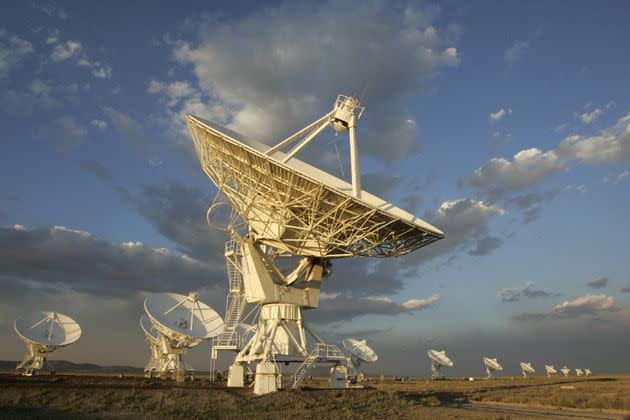Scientists Just Found Out How Space And Time Actually Moves

Very Large Array (VLA), one of the world's premier astronomical radio observatories, on the Plains of San Agustin 50 miles west of Socorro, New Mexico, which was used to help detect the sound of the universe.
Scientists have long thought the whole space-time-continuum thing might just move around us like the ocean – and now it seems, they finally have the evidence.
Hard to wrap your head around? Let us explain.
What did the scientists find?
The astrophysics community has theorised for years that the cosmos moves around us (and everything, in fact), in waves.
Rather than space being empty and time being linear, both are regularly interrupted by gravitational pulls from objects like, oh I don’t know, supermassive black holes.
This causes disruption everywhere, rippling space and time – meaning our universe may till be impacted by things which happened a long, long time ago.
Although, don’t get too excited – that doesn’t mean the human experience is impacted.
Still, that famous physicist Albert Einstein came up with the general theory of relativity back in 1915, but it was too difficult to actually prove.
But, telescopes from around Earth have now detected signs that there is actually a “gravitational wave background”, according to five papers published in the Astrophysical Journal Letters on Wednesday.
Michael Lam, astrophysicist at the SETI Institute and a member of the North American Nanohertz Observatory for Gravitational Waves (NANOGrav), told The Washington Post: “What we measure is the Earth kind of moving in this sea.
“It’s bobbing around – and it’s not just bobbing up and down, it’s bobbing in all directions.”
The papers were simultaneously published after teams in Europe, India, Australia and China all concluded the same thing from their separate studies.
They’ve been looking to find the “low-pitch hum of gravitational waves” through the universe, and washing “through our galaxy to warp space-time in a measurable way” for 15 years, NANOGrav chair Stephen Taylor said at a news briefing on Tuesday.
So yes, it’s also humming.
And yes, that noise is comparable to a “choir or an orchestra” according to another scientist on the NANOGrav collaboration, Xavier Siemens. He told the New York Times: “What we’re receiving is the sum of all those signals at once.”
“It’s really the first time that we have evidence of just this large-scale motion of everything in the universe,” co-director of NANOGrave Maura McLaughlin said.
So, how did they do it?
It all hinged on something called “pulsars”, invisible to the naked human eye, its a type of neutron star, the remains of a dead star.
It spins quickly and releases radio waves in a regular pulse meaning they became cosmic clocks.
Just to detect these ripples, the scientists had to build a detector that was “roughly the size of the galaxy”, according Michael Lam, a researcher with NANOGrav.
Across 15 years, the scientists found these ripples would change every so often – suggesting they were being interrupted by gravitational waves.
This disruption could come from collisions between galaxies, which pushes supermassive black holes (at the centre of the galaxies) closer together, but scientists can’t be sure of that yet.
“Supermassive black hole binaries, slowly and calmly orbiting each other, are the tenors and bass of the cosmic opera,” according to Szabolcs Marka, an astrophysicist at Columbia university who was not involved with the research, in TIME magazine.
If it’s not coming from this though, the scientists said “we would need to come up with some explanation of where those supermassive black holes are hiding and why we’re not seeing their gravitational waves”.
They’re now looking to trace each wave or disruption back to a specific black hole, because at the moment the constant hum is much like standing in the middle of a party.
Well, that’s according to John Hopkins University’s astrophysicist Marc Kaminokowski who wasn’t involved in the research. He said the noise is like being unable to differentiate between a lot of different conversations, because “you’ll hear all of these people talking, but you won’t hear anything in particular”.
Anyway – how’s that existential crisis going?
Related...
Why Scientists Think There May Be Parts Of An Ancient Planet Inside Earth
Here's How You Can Actually Take A Good Picture Of 2023's First Full Supermoon
Why Scientists Think There May Be Parts Of An Ancient Planet Inside Earth
Scientists Just Detected A Signal From 8.8 Billion Years Ago As They 'Peer Into The Early Universe'

 Yahoo News
Yahoo News 